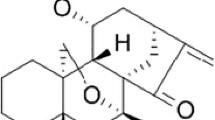Abstract
Objective
To investigate the possible mechanism through which Artemisinin induced apoptosis in pancreatic cell line.
Methods
Column chromatography, thin layer chromatography (TLC) and proton NMR spectroscopy were used to purify Artemisinin. The flowcytometry was employed to detect apoptosis and reactive oxygen species (ROS).
Results
The results indicated that 50% inhibiting concentration (IC50 value) for pancreatic cell line (RIN) was 45 μmol/L of Artemisinin. Artemisinin had no cytotoxic effect on the growth of peripheral blood lymphocytes. The mechanism of apoptosis was evaluated by measuring intracellular ROS. It was shown that Artemisinin-induced apoptosis occurred independently of the binding of CD95L to CD95 receptor in the RIN cells. Moreover, Artemisinin, in a dose-dependent manner, could significantly increase the level of ROS.
Conclusion
Artemisinin can induce apoptosis in the RIN cells via the generation of ROS and triggering the intrinsic pathway of cell death.
Similar content being viewed by others
References
Klayman DL. Qinghaosu (Artemisinin): an antimalarial drug from China. Science 1985;228:1049–1055.
Luo Z, Shen C. The chemistry, pharmacology, and clinical applications of qinghaosu (Artemisinin) and its derivatives. Med Res Rev 1987;7:29–52.
Borstnik K, Paik I, Posner G. Malaria: new chemotherapeutic peroxide drugs. Mini-Reviews in Medicinal Chemistry 2002;2:573–583.
Meshnick S, Yang Y, Lima V, Kuypers F, Kamchonwongpaisan S, Yuthavong Y. Iron-dependent free radical generation from the antimalarial agent Artemisinin (qinghaosu). Antimicrob Agents Chemother 1993;37:1108–1114.
O’Neill P, Posner G. A medicinal chemistry perspective on artemisinin and related endoperoxides. J Med Chem 2004;47:2945–2964.
Robert A, Coppel Y, Meunier B. A lkylation of heme by the antimalarial drug Artemisinin. Chem Commun 2002;5:414–415.
Sanjeev K, Anne-Catrin U, Richard KH. Artemisinins: mechanisms of action and potential for resistance. Drug Resistance Updates 2004;7:233–244.
Nathawut S, Rachanee U, Anake K, Udom C, Samlee M. Redox reaction of Artemisinin with ferrous and ferric ions in aqueous buffer. Chem Pharm Bull 2001;49:1541–1546.
Asawamahasakda W, Ittarat I, Pu Y, Ziffer H, Meshnick S. Reaction of antimalarial endoperoxides with specific parasite proteins. Antimicrob Agents Chemother 1994;38:1854–1858.
Thompson C. Apoptosis in the pathogenesis and treatment of disease. Science 1995;267:1456–1462.
Soini Y, Paakko P, Lehto V. Histopathological evaluation of apoptosis in cancer. Am J Pathol 1998;153:1041–1053.
Chick W, Warren S, Chute R, Like A, Lauris V, Kitchen K. A transplantable insulinoma in the rat. Proc Natl Acad Sci USA 1977;74:628–632.
Efferth T, Dunstan H, Sauerbrey A, Miyachi H, Chitambar C:The anti-malarial artesunate is also active against cancer. Int J Oncol 2001;18:767–773.
Efferth T, Davey M, Olbrich A, Rücher G, Gebbart E, Daveu R. Activity of drugs from traditional Chinese medicine towards sensitive and MDRI- or MRPI-overexpressing multidrug-resistant human CCRF-CEM leukemia cells. Blood Cells Mol Dis 2002;28:160–168.
Berman P, Adams P. Artemisinin enhances hemecatalysed oxidation of lipid membranes. Free Radic Bio Med 1997;22:1283–1288.
Zhang F, Grosser D, Meshnick S. Hemin-catalyzed decomposition of Artemisinin (qinghaosu). Biochem Pharmacol 1992;43:1805–1809.
Singh NP, Lai H. Artemisinin induces apoptosis in human cancer cells. Anticancer Research 2004;24:2277–2280.
Kihara C, Tsunoda T, Tanaka T, Yamana H, Furukawa Y, Ono K, et al. Prediction of sensitivity of esophageal tumor to adjuvant chemotherapy by cDNA microarray analysis of gene-expression profiles. Cancer Res 2001;61:6474–6479.
Singh N, Lai H. Selective toxicity of dihydroartemisinin and holotransferrin toward human breast cancer cells. Life Sci 2001;70:49–56.
Lai H, Singh N. Selective cancer cell cytotoxicity from exposure to dihydro artemisinin and holotransferrin. Cancer Lett 1995;91:41–46.
Price R, van Vugt M, Nosten F, Luxemburger C, Brockman A, Phaipun L, et al. Artesunate versus artemether for the treatment of recrudescent multidrug resistant plasmodium falciparum malaria. Am J Trop Med Hyg 1998;59:883–888.
Efferth T, Briehl M, Tome M. Role of antioxidant genes for the activity of artesunate against tumor cells. Int J Oncol 2003;23:1231–1235.
Meshnick S. Artemisinin: mechanisms of action, resistance and toxicity. Int J Parasitol 2002;32:1655–1660.
Fleury C, Mignotte B, Vayssiere J. Mitochondrial reactive oxygen species in cell death signaling. Biochimie 2002;84:131–141.
Li Y, Wu YL. How Chinese scientists discovered qinghaosu (Artemisinin) and developed its derivatives. What are the future perspectives? Med Trop 1998, 58:9–12.
Author information
Authors and Affiliations
Corresponding author
Rights and permissions
About this article
Cite this article
Noori, S., Hassan, Z.M. & Farsam, V. Artemisinin as a Chinese medicine, selectively induces apoptosis in pancreatic tumor cell line. Chin. J. Integr. Med. 20, 618–623 (2014). https://doi.org/10.1007/s11655-013-1454-2
Received:
Published:
Issue Date:
DOI: https://doi.org/10.1007/s11655-013-1454-2




